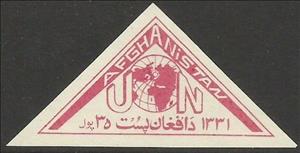Stamp: Globe (Afghanistan 1952)
Globe (Afghanistan 1952)
25 October (Afghanistan ) within release United Nations Day goes into circulation Stamp Globe face value 35 Afghan pul
| Stamp Globe in catalogues | |
|---|---|
| Michel: | Mi: AF 386B |
Stamp is square format.
Also in the issue United Nations Day:
- Stamp - Globe face value 125;
- Stamp - Globe face value 35;
- Stamp - Globe face value 35;
- Stamp - Globe face value 125;
|
Data entry completed
53%
|
|
|---|---|
| Stamp Globe in digits | |
| Country: | Afghanistan |
| Date: | 1952-10-25 |
| Print: | Lithography |
| Perforation: | Imperforate |
| Emission: | Postal Tax |
| Format: | Stamp |
| Face Value: | 35 Afghan pul |
Stamp Globe it reflects the thematic directions:
A globe is a spherical model of Earth, of some other celestial body, or of the celestial sphere. Globes serve purposes similar to maps, but, unlike maps, they do not distort the surface that they portray except to scale it down. A model globe of Earth is called a terrestrial globe. A model globe of the celestial sphere is called a celestial globe
The Kionga Triangle (German: Kionga-Dreieck, Portuguese: Triângulo de Quionga) was a small region of German East Africa situated at the mouth of the Ruvuma River. The Ruvuma served as the border between the German colony and Portuguese Mozambique, and the Kionga Triangle was the only section of German East Africa south of the river. Its principal settlement was Kionga (now Quionga ) which had a population of 4,000 in 1910. It became a German possession in 1894 but came under Portuguese control in April 1916 during World War I. The post-war Treaty of Versailles reaffirmed that the river was the border between Tanganyika, then under British control, and Portuguese Mozambique. The triangle was the only territory that the treaty awarded to Portugal.

